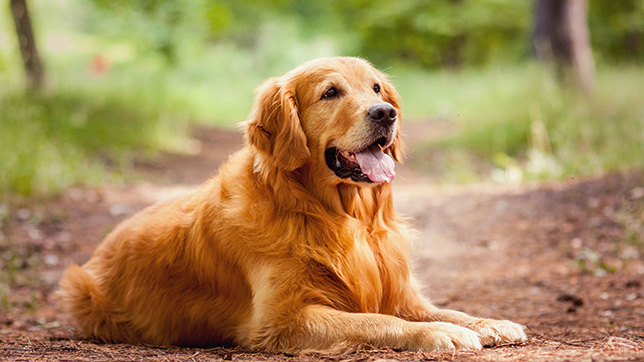Golden Retriever health problems
Joint problems
Hip and Elbow Dysplasia
The Golden Retriever breed suffers from a few genetic health problems, such as hip dysplasia and elbow dysplasia. These are serious joint deformities that can develop to be very painful and debilitating as the dog grows older, and are often only to be remedied with costly orthopaedic surgeries or managed with medications and therapies such as physiotherapy and hydrotherapy.
The breeder from whom you purchase your puppy should have written certifications for the puppy’s parents’ good joint health, as this is the only way to prevent dogs from developing this condition.

Eye problems
Retinal Dysplasia
Retinal Dysplasia can be caused by genetics, infections and exposure to toxins, and can reduce the vision in a dog’s eye. It is an abnormal growth and development at the back of the eye but does not cause the affected dog any pain, meaning it can go unnoticed by owners and vets.
Because of this, diagnosis is usually made when the condition is at an advanced stage where vision loss is obvious. Retinal Dysplasia cannot be prevented or cured, so helping your pet adjust to a life without sight would be the best thing to do.
Progressive Retinal Atrophy (PRA)
Progressive Retinal Atrophy (PRA) is an inherited condition where a dog’s retina degenerates, leading to blindness in affected dogs. Just like Retinal Dysplasia, this condition cannot be prevented and there is no cure. This means, if your Golden Retriever is diagnosed with PRA the best thing to do would be to help your pet prepare and adjust to a life without vision.
Golden Retrievers with PRA should not be bred from as this would be the only way to prevent the condition from being passed on to pups.
Skin problems
Ichthyosis
Another hereditary health problem that can be seen in Golden Retrievers is a skin disease called Ichthyosis. The affected dogs suffer from excessive scale and dandruff flakes. It doesn’t tend to be itchy and Golden Retrievers typically get a mild form of this disease, but it makes their skin more susceptible to secondary skin infections.
There is no cure for the scaling, but in mild cases it can be managed with appropriate skin products to bathe the dog and moisturise the skin.
For the Golden Retriever specifically, there is a DNA test available that can determine whether it is carrying the responsible gene defect. Responsible breeders make sure that their dogs test negative before breeding their dogs and it is recommended that you ask for proof from your breeder before you buy a puppy.
Other Skin Problems
Skin diseases can be found in many Golden Retrievers because their dense undercoat and long outer coat create a perfect environment for the growth of certain bacteria and fungi. Allergies and purulent skin infections occur relatively often. As the owner of a Golden Retriever, it is important to keep an eye on your dog’s skin health.
It is often recommended to support your dog’s skin health with adequate care for fur and skin and regular antiparasitic treatments.
Ear problems
Ear Infections
Like many dogs with floppy ears, the Golden Retriever is very susceptible to ear infections. Sometimes they can be related to allergies or other underlying diseases. You can help prevent them by cleaning your dog’s ears weekly with solutions that are specifically made to keep the skin barrier and the flora in the ear healthy.
In case your dog does develop a red and/or itchy ear, possibly with discharge, it is important that you have your dog checked by your vet.
Heart Problems
Subaortic Stenosis
Certain heart diseases are also more common in Golden Retrievers than in other breeds, such as a condition called subaortic stenosis (SAS). This is a narrowing of the aorta, the big vessel that carries blood away from the heart. It can lead to sudden death, sometimes at a young age.
Upon examination, this disease presents first with a slight heart murmur, which is why we recommend having your dog’s heart checked at least once per year.
Cancer
The Golden Retriever often develops cancerous diseases. The most common ones are:
- hemangiosarcoma – tumour of the blood vessels
- lymphoma – a cancer of the lymphatic tissue
- mast cell tumours – a cancer of a specific cell type of the immune system
- osteosarcoma – an aggressive tumour in bone tissue.
Such cancers can develop at any age, but happen more often as the dogs grow older. It is advisable to look out for a decrease in energy or fitness in your dog and regularly check your dog for lumps and bumps on the body.
Hypothyroidism
One of the hormonal diseases that are often found in Golden Retrievers is called hypothyroidism. It affects the thyroid gland of the dog and results in a lack of thyroxine, a hormone that controls the metabolism of the dog. Signs of this disease are hair loss, dull and thin coat, blackened areas of skin, lethargy, less keen to exercise and weight gain.
This disease shouldn’t be left untreated as it affects the dog’s quality of life. Dogs diagnosed with this condition will need to take oral medication for the rest of their lives.
Looking for more dog advice?
Find the information you need as we support you through every step of your journey with your canine companion.
Need dog insurance?
Dog insurance can help cover the cost of veterinary treatment if your dog gets injured or falls ill.
